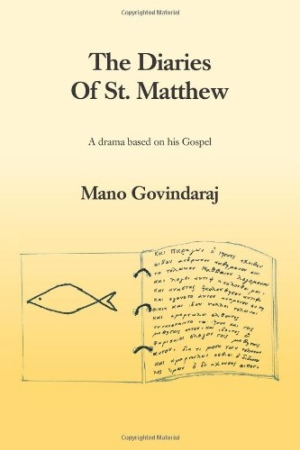The Diaries of St. Matthew
A Drama Based on His Gospel
A snappily cinematic retelling of the Gospel dramatizes Jesus’s biography.
Mano Govindaraj believes the Gospel according to Matthew was written in Jesus’s lifetime, a hypothesis propounded in his previous book, The Authorized Biography of Jesus Christ. In his new book, The Diaries of St. Matthew, which is a dramatization of the Gospel, he presents what the biography might have looked like: Matthew’s daily account of following Jesus, with flashbacks giving details of the Messiah’s ancestry and ministry, plus a final section suggesting the origin of the synoptic Gospels.
Act one has Jesus entering Matthew’s home for a meal and inviting him to be a disciple. Although the Pharisees protest at this tax collector’s uncleanness, Matthew soon becomes Jesus’s close confidant, witnessing and then writing about healings, miracles, the Last Supper, and the trial leading to his crucifixion. Govindaraj is careful to show Matthew in the act of scribing, though varying references to tablets and papyri hint at some confusion about the writing technology of the time.
Some Gospel stories appear as contemporary events, while others are narrated through dramatized flashbacks, filling in, for instance, Mary’s unplanned pregnancy and the Magi’s visit. The conceit of Jesus recounting everything for Matthew’s benefit occasionally feels implausible and necessitates throwaway lines like “Did you get all of it?” The effect at times verges on disrespectful, as in a summary of the Sermon on the Mount that resembles the recap segment of a sporting event.
Although Govindaraj carefully follows layout conventions for dramatic works, the dialogue is stiff throughout—a fatal flaw for a play. Characters use slang unsuitable to the time period, including “Good bye for now,” “Good to know this story,” and “How come?” When compounded by the occasionally odd selection of verbs and prepositions, plus poor spelling, capitalization, and punctuation, the overall writing quality is likely to hamper reading enjoyment. Here is an example of the peculiar phrasing and punctuation (Matthew speaks to Jesus): “Rabbi, while writing it a thought occurred to me about how I can help you in your ministry?”
The most intriguing scene has Matthew attempting to warn Pontius Pilate of the Pharisees’ trumped-up charges against Jesus, a good excuse for Matthew to be present for the whole trial. The crucifixion and resurrection, however, are then given surprisingly short shrift; the author focuses instead on a story not in the Bible about how Matthew’s writing entered the canon. Some months after the Gospel events, Matthew receives a visit from Mark and Luke, who have been writing short accounts of Jesus’s life and wish to compare notes. Govindaraj thus denies the existence of Q, a widely accepted theoretical source document, proposing instead that Matthew inspired Mark and Luke.
There is an interesting theory at the heart of this book, but when all the best lines come directly from scripture, readers might be better off returning to the original. Still, this may interest those looking for a snappily cinematic retelling of the Gospel—if they are willing to overlook the writing’s flaws.
Reviewed by
Rebecca Foster
Disclosure: This article is not an endorsement, but a review. The publisher of this book provided free copies of the book and paid a small fee to have their book reviewed by a professional reviewer. Foreword Reviews and Clarion Reviews make no guarantee that the publisher will receive a positive review. Foreword Magazine, Inc. is disclosing this in accordance with the Federal Trade Commission’s 16 CFR, Part 255.

